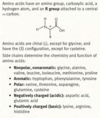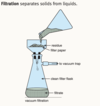Quicksheets Flashcards
(356 cards)
What does the parasympathetic nervous system do?
The parasympathetic nervous system is focused on “rest-and-digest” responses. Think “para” for stop in spanish (parar).

What does the sympathetic nervous system do?
The sympathetic branch of the nervous system is focused on “fight-or-flight” responses.

What are the the three regions of the brain? What structures do they contain?
Hindbrain: contains the cerebellum, medulla oblongata, and reticullar formation
Midbrain: contains the inferior and superior colliculi
Forebrain: contains the thalamus, hypothalamus, basal ganglia, limbic system, and cerebral cortex
What does each region of the forebrain do?
Thalamus
Hypothalamus
Basal ganglia
Limbic system
Thalamus: relay station for sensory information (except olfactory)
Hypothalamus: maintains homeostasis and integrates with the endocrrine system through the hypophyseal portal system that connects it to the anterior pituitary
Basal ganglia: smoothens movements and helps maintain postural stability
Limbic system: contains emotion and memory. Includes septal nuclei (pleasure seeking), amygdala (fear and aggression), hippocampus (memory), and fornix (helps with communication via the limbic system)
List the divisions (lobes) of the cerebral cortex and identify their functions.
Frontal: Executive function, impulse control, long-term planning (prefrontal cortex), motor function (primary motor cortex, precentral gyrus), speech production (Broca’s area)
Parietal: Sensation of touch, pressure, temperature, and pain (somatosensory cortex); spatial processing, orientation, and manipulation
Occipital: Visual processing
Temporal: Sound processing (auditory cortex), speech perception (Wernicke’s area), memory, and emotion (limbic system)

Name the seven major neurotransmittters and some of their functions. (Specifically, their influences on behavior)
Acetylcholine: Voluntary muscle control, parasympathetic nervous system, attention, alertness
Norepinephrine and Epinephrine: Fight-or-flight responses, wakefulness, alertness
Dopamine: Smooth movements, postural stability
Serotonin: Mood, sleep, eating, dreaming
GABA: Brain “stabilization”, anti-anxyolitic
Endorphins: Natural painkillers
Identify two main theories regarding the development of individual traits.
Nature: Genetics.
Nurture: Environment.
Methods for study include family, twin, and adoption studies.
Sensation vs. Perception
Sensation: The conversion of physical stimuli into neurological signals
- Sensory receptors respond to stimuli (afferent) and trigger electrical signals.
- Sensory neurons transmit information from sensory receptors to the CNS.
- Sensory stimuli are transmitted to projection areas in the brain, which further analyze sensory input.
Perception: The processing of sensory information to make sense of its significance.
Sensory thresholds and their relation to a law regarding the nature of a changing stimulus and its effects on perception.
The minimum stimulus that causes a change in signal transduction.
Weber’s law states that the just-noticable difference for a stimulus is proportional to the magnitude of the initial stimulus. This proportion is constant over most of the range of possible stimuli.
Describe signal detection theory, response bias, and adaptation
Signal detection theory is in regard to the effects had by nonsensory factors, such as experiences, motives, and expectations, on perception of stimuli
Response bias: examined using signal detection experiments with the below structure
Adaptation: a decrease in response to a stimulus over time

Describe the structures of the eye, how it detects light, and the visual pathway.
The eye is an organ specialized to detect light in the form of photons.
Visual Pathway: retina -> optic nerve -> optic chiasm -> optic tracts -> lateral genitculate nucleus (LGN) of thalamus -> visual radiations -> visual cortex

Describe the process surrounding audition and the auditory pathway. Name some significant structures.
The ear transduces sound waves into electrical signals that can be interpreted by the brain.
Cochlea: Detects sound via fluid oscillations after the ossicles mechanically vibrate the oval window, that vibration is reverberated through fluid contained in the cochlea that vibrate hair fibers on the organ of corti.
Utricle and saccule: detect linear acceleration (housed in the vestibules)
Semicircular canals: detect rotational acceleration
Auditory pathway: cochlea -> vestibulocochlear nerve -> medial geniculate nucleus of the thalamus -> auditory cortex

Describe the senses smell, taste, somatosensation, and kinesthetic sense
Smell: detection of volatile or aerosolized chemicals by olfactory chemoreceptors (olfactory nerves)
Taste: detection of dissolved compounds by taste buds in papillae
Somatosensation: four touch modalitties (pressure, vibration, pain, and temperature)
Kinesthetic sense (proprioception): ability to tell where one’s body is in space
Describe the the two types of object recognition/visual processing.
Bottom-up (data-driven) processing: recognition of objects by parallel processing and feature detection. Slower, but less prone to mistakes.
Top-down (concept-driven) processing: recognition of an object by memories and expectations, but little attention to detail. Faster, but more prone to mistakes.
Gestal principles: ways that the brain can infer missing parts of an image when it is incomplete.
Describe habituation and dishabituation.
Habituation: The process of becoming used to a stimulus.
Dishabituation: Occurs when a second stimulus intervenes, causing a resensitization to the original stimulus.
Describe two types of learning.
Observational learning: the acquisition of behavior by watching others
Associative learning: pairing together stimuli and responses, or behaviors and consequences (reinforcement)
Describe classical conditioning.
Classical conditioning: a form of associative learning in which a neutral stimulus becomes associated with an unconditioned stimulus such that the neutral stimulus alone produces the same response as the unconditioned stimulus; the neutral stimulus thus becomes a conditioned stimulus

Describe operant conditioning.
Operant conditioning: a form of associative learning in which the frequency of a behavior is modified using reinforcement (increases behavior) or punishment (decreases behavior)

Describe EEG waves for consciousness and each of the stages of sleep. Additionally describe features of each sleep stage.
Sleep disorders including dysomnias (amount or timing of sleeep), such as insomnia, narcolepsy, sleep apnea, and sleep deprivation; and parasomnias (odd behaviors during sleep), such as night terrors and sleepwalking (somnambulism)

Describe the subcomponents of memory and the tasks each is assigned.
Facts are stored via semantic networks. Retrieval of information is often based on prriming interconnected nodes of the semantic network.
Recognition information is stronger than recall.

Describe Piaget’s Stages of Cognitive Development.

Identify components crucial to Problem-solving and Decision-making
Problem-solving techniques include trial-and-error, algorithms, deductive reasoning (deriving conclusions from general rules), and inductive reasoning (deriving generalizations from evidence or examples).
Heuristics are simplified principles used to make decisions (rules of thumb), but biases, intuition, and emotions may contribute to the decision-making process.
Define selective attention and divided attention.
Selective attention: allows one to pay attention to a particular stimulus while determining if additional stimuli require attention in the background.
Divided attention: uses automatic processing to pay attention to multiple activities at one time
Identify the three language areas in the brain & what occurs if each is damaged.























































































































































